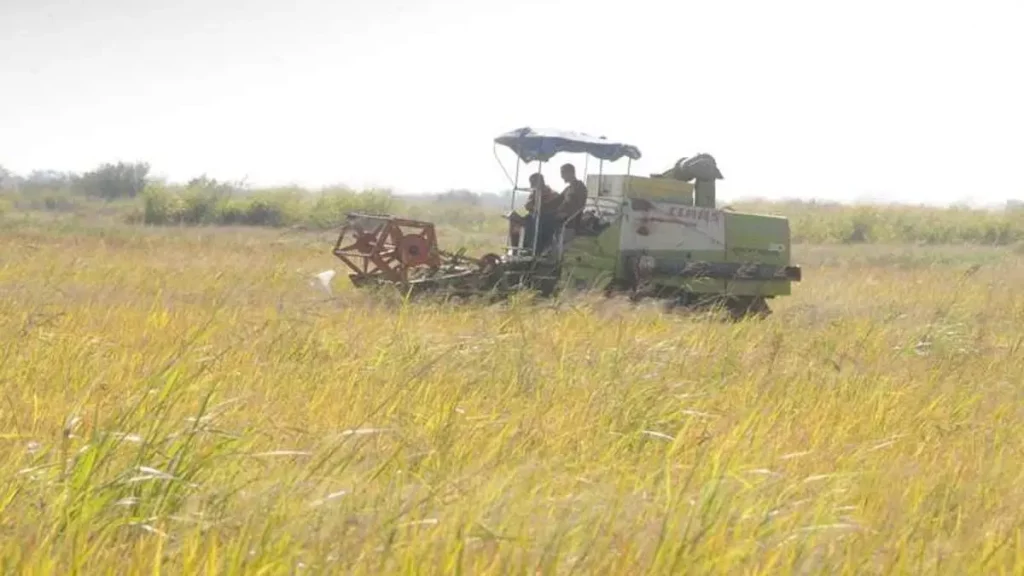Despite the good performance of a Vietnamese company, only 10% of national consumption was covered in 2024

![]() 14ymedio, Madrid, October 8, 2025 — The participation of the private sector in rice production has grown so much that it has already exceeded the State’s contribution. Based on official information, the economist Pedro Monreal deduces that private deliveries increased from 40.8% to 50%, while the State’s share fell from 55.7% to less than 50%.
14ymedio, Madrid, October 8, 2025 — The participation of the private sector in rice production has grown so much that it has already exceeded the State’s contribution. Based on official information, the economist Pedro Monreal deduces that private deliveries increased from 40.8% to 50%, while the State’s share fell from 55.7% to less than 50%.
“The non-State sector contributes 50% of the rice program, which helps to reduce imports of rice,” the leaders of the sector admitted in passing, participating on Tuesday in the television program Mesa Redonda to explain the agricultural production.
The overall picture is very bleak, even with this vital contribution from the private sector. According to the authorities, the new campaign again will not be good, even with outside help. In 2024, Cuba produced 80,000 tons, just over 10% of its domestic consumption.
The drought that the island has suffered throughout the year does not help at all, although the managers hope that the more recent rains, which have improved the filling of some reservoirs, allow for some optimism. Currently, the reservoirs are at 45% on average, “which does not favor rice activity.” However, the forecast for the cold season is to increase the planting in about 20,000 hectares.
Currently, the reservoirs are at 45% on average, “which does not favor rice activity “
“Work is being done on the productive chain between two large enterprises and forms of non-state management, which guarantee the inputs necessary for the campaign, while rice-growing enterprises provide irrigation systems, drainage and industrial infrastructure,” they explained yesterday, recalling that there is foreign investment with “significant impact” in two provinces.
They referred, predictably, to the projects of Pinar del Río (in Los Palacios and Consolación del Sur) and Artemisa, where the Vietnamese company Agri VMA owns land in usufruct, with yields evident to Cuban farmers: 7 tons per hectare compared to the country’s average of 1.5, although this rose to 3.5, thanks to the use of bio-fertilizers to solve the shortage of chemicals.
But it will take more than that to improve production. The managers of Agriculture explained that tractors are being leased -probably those provided by Belarus in exchange for rum and coffee, among other things- and “progress is being made on the opening of six comprehensive logistics centers to sell supplies to producers. The first one, they specified, will open in Pinar del Río, offering seeds and technology packages.
It was not specified in which currency these purchases can be made, since a little more than two weeks ago in the same province a shop opened with “more than 100 supplies and products necessary to guarantee production for the tobacco industry and improve the living conditions of producers.” This is how Tabacuba promoted the store, but the goods can only be bought in freely convertible currency (MLC).
As the authorities warn, “all components of the technology package are not yet available, so agricultural yields will remain low.” In Granma province, they said, 12,000 hectares will be sown during the cold season, with the goal of reaching 30,000 in spring, a “figure not reached since 2018.”
To alleviate this bad omen, which the new non-quantified donation of rice from South Korea will not solve either, it is planned to produce more crops that require less water for their cultivation, such as cassava or bananas. Another protagonist of the cold campaign will be corn, both for direct consumption and feed. According to the managers of the sector yesterday, national production of animal feed is “practically nil.”
Cuba spends more than $1.2 billion annually in the import of five products, one of which is corn
Cuba spends more than $1.2 billion annually on imports of five products, one of which is corn. For this reason, the use of transgenic seeds, which give a better harvest, has been promoted for several years but is not very widespread, as the official newspaper Granma regretted last September.
They plan to plant 1,000 hectares of yucca and as many hectares of banana, while recovering the old areas that specialized in this product in Camagüey, Matanzas and Ciego de Ávila. “We are working this year to rescue those historic areas, which at the time were national references for their productive results,” said Julio Gómez Moldón, vice president of the Agricultural Business Group.
The latter again highlighted the task of two of its best known companies, Ceballos and La Cuba, which this year managed to cultivate 4,000 hectares of bananas, the largest figure in its history. In total, this product is one of the few that meet the projections, and by August more than 16,000 hectares were planted throughout the island.
The managers mentioned more projects that are “dynamic,” from the Yabú Valley, in Villa Clara, to the company of Horquita, in Cienfuegos. But Cubans will have to wait to see the fruits of the planted hectares, and if there is a way to bring them to their tables.
Translated by Regina Anavy
____________
COLLABORATE WITH OUR WORK: The 14ymedio team is committed to practicing serious journalism that reflects Cuba’s reality in all its depth. Thank you for joining us on this long journey. We invite you to continue supporting us by becoming a member of 14ymedio now. Together we can continue transforming journalism in Cuba.
